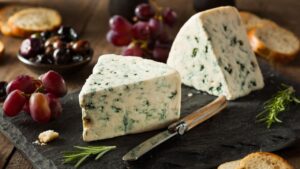The bay leaf is an aromatic and flavorful herb that has been used for thousands of years. Its leaves are often used to flavor soups, stews, sauces, marinades, stocks, and even some desserts. In fact, the bay leaf is so popular that it’s one of the most commonly used herbs in the world.
Bay leaves are actually the leaves of the Laurus nobilis tree, which is native to Greece and Turkey. The Greeks would use them as crowns for their champions during sporting events in honor of their god Apollo. Today you can find bay leaves in most grocery stores and they’re especially popular during the holidays when people use them to flavor dishes like stuffing or turkey gravy.
However, if you want to add a little extra flavor to your favorite dish then consider using an old bay substitute instead!
11 Best Old Bay Substitute
1. Homemade Old Bay Seasoning
Old Bay is a popular spice blend that contains celery salt, paprika, mustard seeds and other herbs and spices. Its name comes from its inclusion of bay leaves as one of its main ingredients. You can make your own version of this seasoning at home that will taste just as good as the original without having to pay for it.
2. Zatarain’s Crab Boil
Zatarain’s Crab Boil is another popular spice blend that contains celery salt, mustard seed, and a small amount of old bay seasoning among other ingredients. It is made specifically for seafood dishes like crawfish boils but can also be used for other types of fish or shellfish dishes as well. It can be found in the spice aisle of the grocery store.
3. Creole Seasoning
Creole seasoning usually contains thyme, paprika, garlic, onion, salt, and pepper. However, different brands can contain different combinations of herbs and spices. Check the ingredients list on the package to make sure you have all the necessary ingredients in this seasoning blend.
4. Todd’s Dirt
This is a great substitute for the old bay. I like to use it in place of the old bay in my shrimp boil recipe. It has a similar flavor but doesn’t have all of the extra salt that old bay has which may make your shrimp too salty. I also like to use it when making hotdogs as well.
5. Seasoned Salt
If you don’t have seasoned salt on hand, you can use regular salt but if you have seasoned salt, then use that instead. Seasoned salt has some flavorings added to it and can really add a lot of flavor to many types of dishes. I like using it in place of garlic powder or onion powder because it adds a bit more flavor than just plain salt does.
Seasoned salt is a mixture of 3/4 cup salt, 1/4 cup sugar, 1/4 cup black pepper, and 1 teaspoon dry mustard. The sugar helps prevent caking, the pepper adds flavor, and the mustard acts as an anti-caking agent. To use this substitute for bay leaves in recipes, substitute it in equal amounts for fresh or dried bay leaves (1 tablespoon per recipe).
6. Cajun Seasoning
Cajun seasoning is a blend of herbs and spices that’s used to season meats. It originated in Louisiana and usually contains garlic powder, onion powder, oregano, black pepper, thyme and paprika. Cajun seasoning is also called blackened seasoning.
7. Celery Salt
Celery salt is a blend of ground celery seed and salt. It can be used as a substitute for table salt in recipes that call for celery seeds. The taste of celery salt is less intense than celery seeds, so it won’t overpower your dish.
8. Chinese Five Spice
Chinese five-spice powder is a spice blend that is used in Chinese cuisine. It is a mixture of at least five spices, with different recipes varying in the precise ingredients, but typically containing star anise, cloves and cinnamon. The mixture may also contain fennel seeds, ginger, Sichuan pepper (Szechuan pepper), licorice root, black cardamom pods or dried orange peel. The spices are often ground together and packaged as a single product.
9. French Four Spice
In French cuisine, quatre épices (“four spices”) is a spice mixture similar to English “pizza seasoning”, but consisting of white pepper, nutmeg, cloves and ginger. The original spice mix was created by medieval monks in Paris to ease digestion after meals.
The French version of four spice is made with ground ginger, nutmeg, mace and white pepper. Use this seasoning in your favorite soups, stews and roasts.
10. Pickling Spice
The ingredient that makes pickles taste like pickles is called “pickling spice,” and it’s a blend of spices that includes coriander, mustard seed, peppercorn, allspice and dill seed. But the spice blend you buy at the grocery store isn’t always purely for pickling — it often has other spices added to it. The most important thing to remember is that if you’re making a recipe that calls for pickling spice, you should use the real thing. Other spice blends may have similar ingredients, but they won’t taste the same.
This is a spice blend that is used in making pickles and other pickled vegetables. It usually contains celery seed, mustard seed, coriander seed, bay leaf, allspice berries and cloves.
11. Celery Seed
This is probably the most common ingredient in pickling spice blends and it gives them their distinctive flavor. It can be found in almost any grocery store or spice shop.
Fresh vs. Dried Bay Leaves
Fresh bay leaves have a stronger taste than dried ones because they contain essential oils that are lost during drying. Fresh bay leaves also tend to be larger than dried ones, so if you’re substituting fresh for dried, use half as many fresh as called for by your recipe.
Cooking With Bay Leaves
Bay leaves are most commonly added to soups and stews. Add one or two whole leaves or several crushed leaves right before serving for best flavor results. Use about one-third as much crushed leaf as whole leaf for best results — whole leaves take longer to infuse their flavor into a dish than crushed ones do. You can also add whole or crushed leaves to rice pilafs or salads for an interesting twist on traditional flavors.
Bay Leaves in the Kitchen
Bay leaves are also used to flavor baked goods and dishes that require marinating, such as roasts and stews. Prior to cooking the dish, lay a few whole or crumbled leaves on the surface of your food to add a hint of bay leaf flavor. Bay leaves also make nice potpourri sachets; float them in bowls of potpourri or place them in drawers and cupboards.
FAQs
What makes Old Bay Seasoning so unique?
Other than being delicious, Old Bay Seasoning is unique because it’s made with a mix of 16 herbs and spices that includes celery salt and mustard seed.
How do I use Old Bay Substitute on my food?
You can sprinkle it on steamed shrimp or crab cakes or add it to salad dressings for an added kick!
What do you use as a substitute for Old Bay Seasoning?
You can find substitutes for Old Bay in most grocery stores or online. Most of them are made with celery, mustard seed, bay leaves, cloves and black pepper. Some also contain paprika and cayenne pepper.
Where can I buy Old Bay Seasoning?
You can find Old Bay Seasoning at most grocery stores or online. It’s not as common as other spices, but it’s still fairly easy to find in most major cities and even some smaller ones.
What does Old Bay Seasoning taste like?
Old Bay Seasoning tastes like a combination of allspice and celery seed with hints of nutmeg and ginger — but the blend depends on which brand you buy! Some brands are sweeter than others, and some have more heat than others.
Conclusion
In conclusion, the Old Bay Seasoning is a very popular and flavorful spice mix. It is used to flavor seafood dishes like crab cakes, crab bisque, and other seafood dishes. It has a unique blend of herbs and spices like celery seed, mustard seed, paprika, turmeric, and black pepper. This seasoning contains no salt but it tastes great with all types of meat, poultry, and vegetables.
The good old bay substitute is an Old Bay Seasoning. The main reason why it is popular is that it is cheaper than Old Bay and there are many recipes you can use with it.





